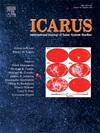Planetary surface dating from crater size–frequency distribution measurements: Sequence probability and simultaneous formation. Did the close Chang'E-6 mare units form simultaneously?
IF 2.5
2区 物理与天体物理
Q2 ASTRONOMY & ASTROPHYSICS
引用次数: 0
Abstract
The Chang'e-6 lunar spacecraft returned samples from the southern mare of the Apollo basin. This work analyses the likelihood that a set of six close crater dating measurements of sub-units near the sampling site actually represent a single formation event. Using theoretical considerations, we find that the measurements are consistent with a simultaneous formation hypothesis with about 1 in 6 likelihood, so that a close sequential formation is more probable. Results of radioisotope dating of basaltic fragments from the surface scoop sample were recently reported close to 2.8 Ga. Our crater dating of the vicinity suggests that the upper 2–17 m predominantly records an age of , which points to the samples' formation predating this crater population reset of the surface.
从陨石坑大小-频率分布测量测定行星表面年代:序列概率和同时形成。近距离的嫦娥六号多单元是否同时形成?
嫦娥六号月球探测器从阿波罗盆地南部带回了样本。这项工作分析了采样点附近亚单元的一组六个近距离陨石坑测年结果实际上代表单一形成事件的可能性。使用理论考虑,我们发现测量结果与同时形成的假设一致,大约有1 / 6的可能性,因此紧密的顺序形成更有可能。最近报道了来自表面勺状样品的玄武岩碎片的放射性同位素定年结果接近2.8 Ga。附近2 ~ 17 m的陨坑测年结果表明,样品的年龄主要为μ1.66−0.054+0.053Ga,表明样品的形成时间早于陨坑种群的表面重置。
本文章由计算机程序翻译,如有差异,请以英文原文为准。
求助全文
约1分钟内获得全文
求助全文
来源期刊

Icarus
地学天文-天文与天体物理
CiteScore
6.30
自引率
18.80%
发文量
356
审稿时长
2-4 weeks
期刊介绍:
Icarus is devoted to the publication of original contributions in the field of Solar System studies. Manuscripts reporting the results of new research - observational, experimental, or theoretical - concerning the astronomy, geology, meteorology, physics, chemistry, biology, and other scientific aspects of our Solar System or extrasolar systems are welcome. The journal generally does not publish papers devoted exclusively to the Sun, the Earth, celestial mechanics, meteoritics, or astrophysics. Icarus does not publish papers that provide "improved" versions of Bode''s law, or other numerical relations, without a sound physical basis. Icarus does not publish meeting announcements or general notices. Reviews, historical papers, and manuscripts describing spacecraft instrumentation may be considered, but only with prior approval of the editor. An entire issue of the journal is occasionally devoted to a single subject, usually arising from a conference on the same topic. The language of publication is English. American or British usage is accepted, but not a mixture of these.
 求助内容:
求助内容: 应助结果提醒方式:
应助结果提醒方式:


